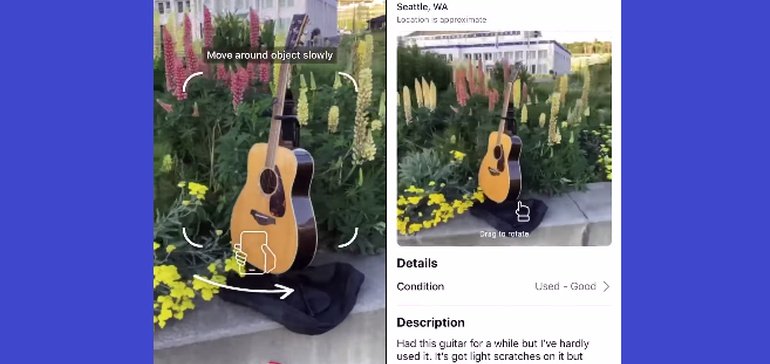Facebook Tests 3D Product Images in Marketplace Among Advanced AI and AR Shopping Initiatives

While Facebook takes a big leap into eCommerce with its new Shop options for both Facebook and Instagram, it’s also working on a range of more advanced AR and AI-based tools to improve the online shopping experience.
This week, The Social Network has outlined some of its evolving digital shopping tools, which are designed to make product recommendations more personalized, and address limitations in virtual product assessment.
First off, Facebook’s testing out a new 3D-like option which enables Marketplace sellers to provide a full view of their items within their listings.
As explained by Facebook:
“We’re introducing Rotating View, a state-of-the-art 3D-like photo capability that allows anyone with a camera on their phone to capture multi-dimensional panoramic views of their listings on Marketplace. This feature allows any seller with a camera phone to turn regular 2D video into a 3D-like interactive view. We’ve started testing this feature on Marketplace for iOS Sellers to start.”
One of the key challenges in not being able to physically view and hold an item is that you don’t know what you’re getting, and while questionable online shopping experiences have left many regular buyers helpfully skeptical, there are still challenges in ensuring that you’re getting what you’re agreeing to pay for. 3D visuals can help with this, showing any potential flaws or issues that you might not get with a selectively angled image.
Also on Marketplace, Facebook’s using a new, machine-learning based system to help sellers better tag their items.
“This new system, called GrokNet, automatically suggests attributes such as colors and materials when sellers upload a photo of an item for sale on Marketplace, which makes posting a listing much easier. And on the buyer’s side, predicted detailed descriptions provided by [the] system allow you to search Marketplace not just for black chairs, for example, but specifically for a black leather sectional sofa – even if the seller didn’t explicitly add those details to the description.”
GrokNet can also automatically provide product tag suggestions for Facebook Pages, which could help businesses using the new Shop option to maximize discovery of their items.
“When Page admins upload a photo, GrokNet can suggest potential products to tag by visually matching between items in the photo and the Page’s product catalog.”
That’s somewhat similar to Pinterest’s object identification tools, which can pinpoint specific items in an image to use for search and discovery across the platform – though Facebook’s system is more specifically aligned to the products uploaded by that Page.
That could make it easier to generate interest in your offerings – simply upload a photo with your products in it, as you normally would, and Facebook’s system will tag the products you have listed, and facilitate direct connection to those listings in your shop.
The process is currently in testing.
Looking even further ahead, Facebook is also testing new, AI-based tools that will be able to learn what style of clothing you prefer based on your existing wardrobe, then make product recommendations based on this.
“[We’re] prototyping an intelligent digital closet, which lets you take photos of your outfits and digitize each item within seconds. The digital closet can provide not only outfit suggestions based on planned activities or weather but also fashion inspiration based on products and styles that you like, so you can shop in the context of what you already own.”
That, also, sounds similar to Pinterest’s ‘Shop the Look’ Pins, which identify items to buy based on a photo – but again, Facebook’s system is a little different. In this instance, Facebook’s process is looking to utilize advanced matching systems to improve relevant discovery based on your existing wardrobe preferences, as opposed to what might look good on a model in an image.
Facebook also says that it’s working on developing new AR try-on type tools for products, which enable users to see how they look in, for example, branded sunglasses based on an ad or Page visit.
Instagram started testing these AR ads with selected partner brands late last year, and Facebook says that it’s looking to expand on this “to support more businesses and products in the future”.
The key to all of this, of course, is simplicity. Facebook shopping won’t work if it’s difficult for merchants to upload their product catalogs, on-platform buying won’t work if the experience isn’t great, and convenient, for consumers. Facebook knows this, which is why it’s taken so long to make the next leap into broader eCommerce offerings.
Enabling on-platform buying makes sense, but if it’s not easy, on all sides, it will clutter Facebook and Instagram, and potentially turn users away due to over-commercialization.
But if Facebook can get it right, it could be huge – and these new tools in testing point to the next phase of that shift, when eCommerce becomes a more integrated, intelligent way to shop.
Facebook Faces Yet Another Outage: Platform Encounters Technical Issues Again

Uppdated: It seems that today’s issues with Facebook haven’t affected as many users as the last time. A smaller group of people appears to be impacted this time around, which is a relief compared to the larger incident before. Nevertheless, it’s still frustrating for those affected, and hopefully, the issues will be resolved soon by the Facebook team.
Facebook had another problem today (March 20, 2024). According to Downdetector, a website that shows when other websites are not working, many people had trouble using Facebook.
This isn’t the first time Facebook has had issues. Just a little while ago, there was another problem that stopped people from using the site. Today, when people tried to use Facebook, it didn’t work like it should. People couldn’t see their friends’ posts, and sometimes the website wouldn’t even load.
Downdetector, which watches out for problems on websites, showed that lots of people were having trouble with Facebook. People from all over the world said they couldn’t use the site, and they were not happy about it.
When websites like Facebook have problems, it affects a lot of people. It’s not just about not being able to see posts or chat with friends. It can also impact businesses that use Facebook to reach customers.
Since Facebook owns Messenger and Instagram, the problems with Facebook also meant that people had trouble using these apps. It made the situation even more frustrating for many users, who rely on these apps to stay connected with others.
During this recent problem, one thing is obvious: the internet is always changing, and even big websites like Facebook can have problems. While people wait for Facebook to fix the issue, it shows us how easily things online can go wrong. It’s a good reminder that we should have backup plans for staying connected online, just in case something like this happens again.
Christian family goes in hiding after being cleared of blasphemy

LAHORE, Pakistan — A court in Pakistan granted bail to a Christian falsely charged with blasphemy, but he and his family have separated and gone into hiding amid threats to their lives, sources said.
Haroon Shahzad, 45, was released from Sargodha District Jail on Nov. 15, said his attorney, Aneeqa Maria. Shahzad was charged with blasphemy on June 30 after posting Bible verses on Facebook that infuriated Muslims, causing dozens of Christian families in Chak 49 Shumaali, near Sargodha in Punjab Province, to flee their homes.
Lahore High Court Judge Ali Baqir Najfi granted bail on Nov. 6, but the decision and his release on Nov. 15 were not made public until now due to security fears for his life, Maria said.
Shahzad told Morning Star News by telephone from an undisclosed location that the false accusation has changed his family’s lives forever.
“My family has been on the run from the time I was implicated in this false charge and arrested by the police under mob pressure,” Shahzad told Morning Star News. “My eldest daughter had just started her second year in college, but it’s been more than four months now that she hasn’t been able to return to her institution. My other children are also unable to resume their education as my family is compelled to change their location after 15-20 days as a security precaution.”
Though he was not tortured during incarceration, he said, the pain of being away from his family and thinking about their well-being and safety gave him countless sleepless nights.
“All of this is due to the fact that the complainant, Imran Ladhar, has widely shared my photo on social media and declared me liable for death for alleged blasphemy,” he said in a choked voice. “As soon as Ladhar heard about my bail, he and his accomplices started gathering people in the village and incited them against me and my family. He’s trying his best to ensure that we are never able to go back to the village.”
Shahzad has met with his family only once since his release on bail, and they are unable to return to their village in the foreseeable future, he said.
“We are not together,” he told Morning Star News. “They are living at a relative’s house while I’m taking refuge elsewhere. I don’t know when this agonizing situation will come to an end.”
The Christian said the complainant, said to be a member of Islamist extremist party Tehreek-e-Labbaik Pakistan and also allegedly connected with banned terrorist group Lashkar-e-Jhangvi, filed the charge because of a grudge. Shahzad said he and his family had obtained valuable government land and allotted it for construction of a church building, and Ladhar and others had filed multiple cases against the allotment and lost all of them after a four-year legal battle.
“Another probable reason for Ladhar’s jealousy could be that we were financially better off than most Christian families of the village,” he said. “I was running a successful paint business in Sargodha city, but that too has shut down due to this case.”
Regarding the social media post, Shahzad said he had no intention of hurting Muslim sentiments by sharing the biblical verse on his Facebook page.
“I posted the verse a week before Eid Al Adha [Feast of the Sacrifice] but I had no idea that it would be used to target me and my family,” he said. “In fact, when I came to know that Ladhar was provoking the villagers against me, I deleted the post and decided to meet the village elders to explain my position.”
The village elders were already influenced by Ladhar and refused to listen to him, Shahzad said.
“I was left with no option but to flee the village when I heard that Ladhar was amassing a mob to attack me,” he said.
Shahzad pleaded with government authorities for justice, saying he should not be punished for sharing a verse from the Bible that in no way constituted blasphemy.
Similar to other cases
Shahzad’s attorney, Maria, told Morning Star News that events in Shahzad’s case were similar to other blasphemy cases filed against Christians.
“Defective investigation, mala fide on the part of the police and complainant, violent protests against the accused persons and threats to them and their families, forcing their displacement from their ancestral areas, have become hallmarks of all blasphemy allegations in Pakistan,” said Maria, head of The Voice Society, a Christian paralegal organization.
She said that the case filed against Shahzad was gross violation of Section 196 of the Criminal Procedure Code (CrPC), which states that police cannot register a case under the Section 295-A blasphemy statute against a private citizen without the approval of the provincial government or federal agencies.
Maria added that Shahzad and his family have continued to suffer even though there was no evidence of blasphemy.
“The social stigma attached with a blasphemy accusation will likely have a long-lasting impact on their lives, whereas his accuser, Imran Ladhar, would not have to face any consequence of his false accusation,” she said.
The judge who granted bail noted that Shahzad was charged with blasphemy under Section 295-A, which is a non-cognizable offense, and Section 298, which is bailable. The judge also noted that police had not submitted the forensic report of Shahzad’s cell phone and said evidence was required to prove that the social media was blasphemous, according to Maria.
Bail was set at 100,000 Pakistani rupees (US $350) and two personal sureties, and the judge ordered police to further investigate, she said.
Shahzad, a paint contractor, on June 29 posted on his Facebook page 1 Cor. 10:18-21 regarding food sacrificed to idols, as Muslims were beginning the four-day festival of Eid al-Adha, which involves slaughtering an animal and sharing the meat.
A Muslim villager took a screenshot of the post, sent it to local social media groups and accused Shahzad of likening Muslims to pagans and disrespecting the Abrahamic tradition of animal sacrifice.
Though Shahzad made no comment in the post, inflammatory or otherwise, the situation became tense after Friday prayers when announcements were made from mosque loudspeakers telling people to gather for a protest, family sources previously told Morning Star News.
Fearing violence as mobs grew in the village, most Christian families fled their homes, leaving everything behind.
In a bid to restore order, the police registered a case against Shahzad under Sections 295-A and 298. Section 295-A relates to “deliberate and malicious acts intended to outrage religious feelings of any class by insulting its religion or religious beliefs” and is punishable with imprisonment of up to 10 years and fine, or both. Section 298 prescribes up to one year in prison and a fine, or both, for hurting religious sentiments.
Pakistan ranked seventh on Open Doors’ 2023 World Watch List of the most difficult places to be a Christian, up from eighth the previous year.
Morning Star News is the only independent news service focusing exclusively on the persecution of Christians. The nonprofit’s mission is to provide complete, reliable, even-handed news in order to empower those in the free world to help persecuted Christians, and to encourage persecuted Christians by informing them that they are not alone in their suffering.
Free Religious Freedom Updates
Join thousands of others to get the FREEDOM POST newsletter for free, sent twice a week from The Christian Post.
Individual + Team Stats: Hornets vs. Timberwolves
CHARLOTTE HORNETS MINNESOTA TIMBERWOLVES You can follow us for future coverage by liking us on Facebook & following us on X: Facebook – All Hornets X – …
Source link
-

 MARKETING7 days ago
MARKETING7 days agoA Recap of Everything Marketers & Advertisers Need to Know
-

 PPC5 days ago
PPC5 days agoHow the TikTok Algorithm Works in 2024 (+9 Ways to Go Viral)
-

 SEO6 days ago
SEO6 days agoBlog Post Checklist: Check All Prior to Hitting “Publish”
-

 SEO4 days ago
SEO4 days agoHow to Use Keywords for SEO: The Complete Beginner’s Guide
-

 MARKETING5 days ago
MARKETING5 days agoHow To Protect Your People and Brand
-

 SEARCHENGINES6 days ago
SEARCHENGINES6 days agoGoogle Started Enforcing The Site Reputation Abuse Policy
-

 PPC6 days ago
PPC6 days agoHow to Craft Compelling Google Ads for eCommerce
-

 MARKETING6 days ago
MARKETING6 days agoElevating Women in SEO for a More Inclusive Industry



